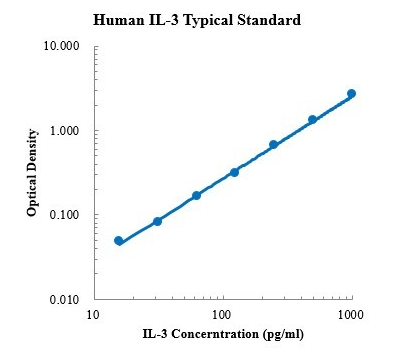| Description | Detection Principle: This kit uses double antibody sandwich ELISA technology. Specific anti-human IL-3 capture antibody was pre coated on a high affinity microplate. Add the standard, the sample to be tested and the biotin labeled detection antibody into the wells of the enzyme plate in turn, shake well and mix well, and then place it at room temperature for 2 hours of incubation process. The IL-3 in the sample combines with the solid-phase antibody and the detection antibody. After washing sufficiently to remove free and unbound components, streptavidin HRP (sa-hrp) labeled with horseradish peroxidase was added. After washing again, TMB chromogenic substrate was added and incubated at room temperature in the dark to develop color. The depth of color response is positively correlated with the concentration of IL-3 in the sample. Add stop solution to stop the reaction, and use a microplate reader to measure the absorbance value at 450 nm detection wavelength (correction wavelength 570-630 nm). Detection Type: Double antibody sandwich method Form: Pre coated 96 well plate Test Sample Type: cell supernatant, serum, plasma Loading Amount: 100 μ L Kit Components: A copy of pre coated 96 well plate, standard, IL-3 detection antibody, standard dilution, detection buffer, TMB chromogenic substrate, washing solution, termination solution, sa-hrp, plate sealing membrane and instructions. Sensitivity: 0.94pg/ml Detection Range: 15.63-1000 pg/ml Recovery Range: 87-119% Storage Method: 2-8 ℃ Standard Curve: 
Background: Interleukin 3 (IL-3) is encoded by the IL3 gene in humans. It is a biological signal (cytokine)It can be used as a part of the immune system to improve the innate immune response to disease. It is secreted by basophils and activated T cells, and can assist the growth and differentiation of bone marrow-derived T cells in the immune response. IL-3 acts by binding to IL-3 receptor, which can stimulate multipotent hematopoietic stem cells to differentiate into myeloid progenitor cells, or together with IL-7, stimulate multipotent hematopoietic stem cells to differentiate into lymphoid progenitor cells. In addition, IL-3 and other cytokines, such as erythropoietin (EPO), granulocyte macrophage colony-stimulating factor (GM-CSF) and IL-6, stimulate the proliferation of all cells of the myeloid system (granulocytes, monocytes and dendritic cells). |





